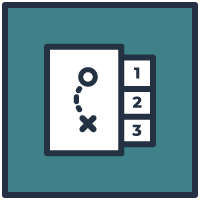Universal TA
According to the OSEP definition, universal TA involves support and information that can be accessed independently with minimal assistance from project staff. The purpose is to provide useful information to raise awareness and increase knowledge.
Information Dissemination
There are a wide variety of ways to keep families on your child count informed of events and key resources, including:
- Email or social media updates
- A newsletter
- A website with information about your project’s activities and opportunities for family involvement
- Resource packets for different educational stages or areas of need (e.g., early intervention, transition, behavior)
- A lending library (e.g., books, videos, assistive technology resources)
- Information about deaf-blindness and your project’s services distributed at state events and conferences
- Event reminders via phone or text (e.g., Phonevite)
Collaborating with your Parent Center and other relevant state partners on information dissemination activities will help you reach more families and learn about new resources to share.
Welcome Process for New Families
It’s important to have a clearly outlined welcome process ready so that you can quickly reach out to families whenever you receive a new referral to add a child to your census. The process should include how you will make initial contact (e.g., phone, letter, email) and follow-up materials that describe your project. Oftentimes, the welcome is accomplished by sending a letter (sample state deaf-blind project letters) officially welcoming the family and outlining your project's services, such as:
- Who is on your project and their roles
- Where you are based
- How to contact you
- Services you offer (e.g., training, consultation) and time constraints related to those services
- A little about yourself (so you are not just another professional knocking on their door)
Let them know that you will follow-up within a predetermined amount of time (preferably two weeks) to learn more about their family and child
Child referrals come from a variety of people, including educators, health care providers, and family members themselves. Reach out to all families with this information regardless of how you received their contact information.
Presentations
Presentations may be either universal or targeted TA. The difference is in the intensity. Universal TA presentations are typically short, one-time offerings such as a webinar or conference presentation. They might be just for families, but are also opportunities to provide information about the needs of families of children who are deaf-blind to Parent Centers or other agencies.
Brief Interactions
One-time very brief interactions by phone or email to respond to simple questions, provide quick information, or update child count information are also a form of universal TA. This could include written material (e.g., information about cortical visual impairment) or referrals to services or organizations (e.g., Parent Centers, NFADB).
